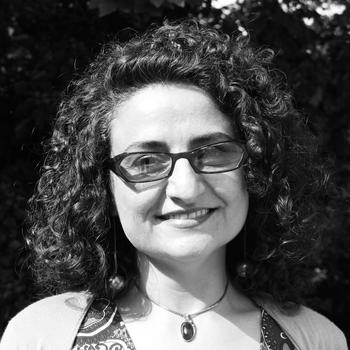Proshot Kalami

Interweaving Performance Cultures
Fellow 2011/12, 2012/13
Proshot Kalami received her PhD in Comparative Literature & Cinema from the University of California, Davis, in 2007. Prior to that, she was a teacher, playwright & radio director in Tehran, Iran. In the USA, she taught at the University of California (Berkeley, Santa Cruz and Davis), before moving to the UK to be a lecturer at Loughborough University. In 2009, she was dramaturge for the London production of Death of Yazdgerd, a play by Iranian playwright, Bahram Beyzaie, directed by Dr Sudipto Chatterjee. As a live performance videographer, she has worked with the Asia Society of North America, Brooklyn Academy of Music (New York), Cal Performances (UC Berkeley), Mondavi Center (UC Davis), Chorus Repertory Theatre (Manipur, India) and the Barbican (London). Alongside a number of essays on world cinema in international journals, Kalami has published two poetry anthologies in Farsi. Her book, Iran’s Reel Spectre: The Cinematic Story of a Nation, is forthcoming in 2013.
Research Project
The Man of the Heart Project
Working primarily as a videographer and then as a documentarian of the Man of the Heart project, I have followed the genesis of the performance from its earliest days in 2005, when its text was being conceived by Sudipto Chatterjee, and the performance composed by director Suman Mukherjee.
My interest in the cultural performances of the Baul-Phokirs of Bengal thus was informed by the relation of the camera to performance as a practice of everyday life, differences and divides between the urban and the rural, theory and practice, as well as between folk and institutionalised performance art. The questions I have pursued in the past seven years are related to issues of ‘site’, ‘locality’ and ‘context’ in relation to rituals and cultural performances as fabrics of everyday life. These constitutive questions include: How does Man of the Heart as an urban performance relate to the documenting camera that represents and/or interrogates? As documentarian, I investigate whether my camera is speculative, intrusive or exoticising in relation to the subject it ‘shoots’.
In my research, I also question how I should approach and negotiate terms such as ‘site’ in ‘site of performance’, be it a ritual or an artistic rendition of that ritual, informed by urban knowledge. To see samples of my work on the project, please visit www.lalon.org.
Recommended Publications
-
de Certeau, M., Heterologies, Discourse on the Other, Minneapolis: University of Minnesota Press, 2006.
-
de Certeau, M., The Practice of Everyday Life, Berkeley: University of California Press, 1988.
-
Barthes, R., Camera Lucida, Reflection on Photography, New York: Howard, Farrar, Stuart and Giroux, 1981.
-
Weinberger, E., “The Camera People,” in Transition, no. 55, 1992, pp. 24-54.
-
Salomon, C., “The Bauls,” in D. S. Lopez (ed.) Religions of India in Practice, Princeton: Princeton University Press, 1995.
